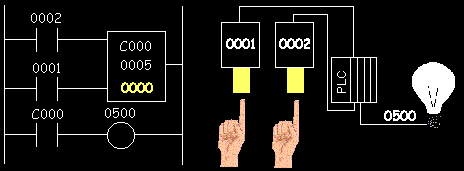A PLC (i.e. Programmable Logic Controller) is a device that was invented to replace the necessary sequential relay circuits for machine control. The PLC works by looking at its inputs and depending upon their state, turning on/off its outputs. The user enters a program, usually via software, that gives the desired results.
PLCs are used in many "real world" applications. If there is industry present, chances are good that there is a plc present. If you are involved in machining, packaging, material handling, automated assembly or countless other industries you are probably already using them. If you are not, you are wasting money and time. Almost any application that needs some type of electrical control has a need for a plc.
For example, let's assume that when a switch turns on we want to turn a solenoid on for 5 seconds and then turn it off regardless of how long the switch is on for. We can do this with a simple external timer. But what if the process included 10 switches and solenoids? We would need 10 external timers. What if the process also needed to count how many times the switches individually turned on? We need a lot of external counters.
As you can see the bigger the process the more of a need we have for a PLC. We can simply program the PLC to count its inputs and turn the solenoids on for the specified time.
This site gives you enough information to be able to write programs far more complicated than the simple one above. We will take a look at what is considered to be the "top 20" plc instructions. It can be safely estimated that with a firm understanding of these instructions one can solve more than 80% of the applications in existence.
That's right, more than 80%! Of course we'll learn more than just these instructions to help you solve almost ALL your potential plc applications.
An Example of Animated PLC Working:

PLC Parts :
PLC History
In
the late 1960's PLCs were first introduced. The primary reason for
designing such a device was eliminating the large cost involved in
replacing the complicated relay based machine control systems. Bed ford
Associates (Bed ford, MA) proposed something called a Modular Digital
Controller (MOD ICON) to a major US car manufacturer. Other companies at
the time proposed computer based schemes, one of which was based upon
the PDP-8. The MOD ICON 084 brought the world's first PLC into commercial
production.
When
production requirements changed so did the control system. This becomes
very expensive when the change is frequent. Since relays are mechanical
devices they also have a limited lifetime which required strict
adhesion to maintenance schedules. Troubleshooting was also quite
tedious when so many relays are involved. Now picture a machine control
panel that included many, possibly hundreds or thousands, of individual
relays. The size could be mind boggling. How about the complicated
initial wiring of so many individual devices! These relays would be
individually wired together in a manner that would yield the desired
outcome. Were there problems? You bet!
These
"new controllers" also had to be easily programmed by maintenance and
plant engineers. The lifetime had to be long and programming changes
easily performed. They also had to survive the harsh industrial
environment. That's a lot to ask! The answers were to use a programming
technique most people were already familiar with and replace mechanical
parts with solid-state ones.
In the mid70's the
dominant PLC technologies were sequencer state-machines and the
bit-slice based CPU. The AMD 2901 and 2903 were quite popular in Modicon
and A-B PLCs. Conventional microprocessors lacked the power to quickly
solve PLC logic in all but the smallest PLCs. As conventional
microprocessors evolved, larger and larger PLCs were being based upon
them. However, even today some are still based upon the 2903.(ref A-B's
PLC-3) Mod icon has yet to build a faster PLC than their 984A/B/X which
was based upon the 2901.
Communications
abilities began to appear in approximately 1973. The first such system
was Mod icon's Mod bus. The PLC could now talk to other PLCs and they
could be far away from the actual machine they were controlling. They
could also now be used to send and receive varying voltages to allow
them to enter the analog world. Unfortunately, the lack of
standardization coupled with continually changing technology has made
PLC communications a nightmare of incompatible protocols and physical
networks. Still, it was a great decade for the PLC!
The 80's saw
an attempt to standardize communications with General Motor's
manufacturing automation protocol(MAP). It was also a time for reducing
the size of the PLC and making them software programmable through
symbolic programming on personal computers instead of dedicated
programming terminals or handheld programmers. Today the world's
smallest PLC is about the size of a single control relay!
The 90's have
seen a gradual reduction in the introduction of new protocols, and the
modernization of the physical layers of some of the more popular
protocols that survived the 1980's. The latest standard (IEC 1131-3)
has tried to merge plc programming languages under one international
standard. We now have PLCs that are programmable in function block
diagrams, instruction lists, C and structured text all at the same time!
PC's are also being used to replace PLCs in some applications. The
original company who commissioned the MOD ICON 084 has actually switched
to a PC based control system.














Very informative.
ReplyDeleteThanks Thagmal ..
Deletegreat post.
ReplyDelete